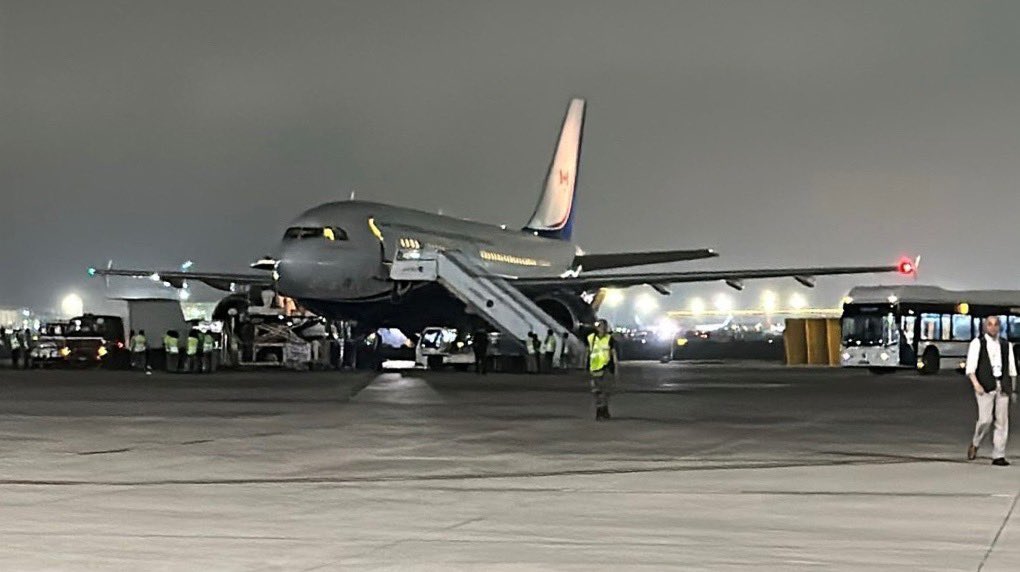The Canadian Prime Minister, Justin Trudeau, and his contingent and members of the media, who had arrived in India last week to participate in the group of 20 (G20) leaders summit, which India hosted in Delhi over the weekend, had tough luck getting out after the summit got over.

CFC001 at Delhi Airport (Credit: Unknown)
The Canadian Executive Transport A310
The Royal Canadian Air Force (RCAF) is tasked with operating a specialised fleet of aircraft to transport Canada’s monarch and members of the Government of Canada. Canada’s 437 Transport Squadron operates five Airbus A310-300s designated as Airbus CC-150 Polaris. These are all civilian Airbus A310-300 aircraft which have been converted into multi-purpose, long-range jets for executive transport, freight, medical transport or mid-air refuelling missions for the RCAF.
The five Airbus aircraft that comprise the fleet were civilian airliners originally operated by Wardair. The aircraft were first delivered in 1987 and 1988 and subsequently sold to the Canadian Armed Forces and converted for military use, entering service between December 1992 and August 1993. Four aircraft are converted to the Combi-Freighter standard, with a reinforced floor and side opening cargo door. The fifth was modified as a VIP transport aircraft for government executive transport.
This 35-year-old jet has been used to jet around Canadian dignitaries around the globe. One of the other aircraft has been stranded in Guam since July 2023 after an incident involving the Canadian plane and a French A400M aircraft.
The executive transport aircraft had incidents in 2016, where it developed a snag before getting to Brussels. In 2019, the plane suffered extensive damage in Ottawa itself. The end of life of this aircraft is predicted to be in 2027.
What happened in Delhi?
On the current trip, Justin Trudeau was forced to stay back in India on an extended trip which lasted approximately two days more than the initially scheduled departure on Sunday night, as Can Force One, which is the code for CFC001, developed a snag before departure from India. The Airbus A310 had flown Trudeau to Delhi from Singapore on September 8 and was to leave for Ottawa via Rome on Sunday when a glitch was detected.

On the evening of September 10, 2023, the Canadian Prime Minister’s Office issued the following statement,
Upon our departure for the airport, we were made aware by the Canadian Armed Forces that CFC001 was experiencing technical issues. These issues are not fixable overnight, our delegation will be staying in India until alternate arrangements are made.
The Canadian Air Force reportedly dispatched another jet to pick up the contingent; however, this jet was diverted to London as the CFC001 was fixed. Justin Trudeau and the delegation took off from Delhi at 1:10 PM IST to head to Rome and to Ottawa after a refuelling stop.
https://x.com/Rajeev_GoI/status/1701514685277999531?s=20
Replacement Plans
In 2021, the Government of Canada began an effort to replace all the CC-150 Polaris aircraft. Canada has so far announced that it has finalised a contract to acquire two A330-200 planes as the first two aircraft for the Royal Canadian Air Force (RCAF) that will provide strategic transport and air-to-air refuelling capabilities. The Air Force intends to build a fleet of nine aircraft (four new and five used). However, it is unclear how quickly this fleet will be up and running.
Bottomline
While Government Jets are primarily supposed to work for long years given their sparing use case, recently, we have seen embarrassing situations, first for Germany and now for Canada, where the jets have been problematic during the mission they were flying rather than when the aircraft was supposed to be on the ground under maintenance. The Canadian RCAF uses an A310 for the Canadian PM transport, and he was recently stuck in India after the G20 summit due to this.
What do you make of the ageing fleet of Canada’s government transport planes?
Liked our articles and our efforts? Please pay an amount you are comfortable with; an amount you believe is the fair price for the content you have consumed. Please enter an amount in the box below and click on the button to pay; you can use Netbanking, Debit/Credit Cards, UPI, QR codes, or any Wallet to pay. Every contribution helps cover the cost of the content generated for your benefit.
(Important: to receive confirmation and details of your transaction, please enter a valid email address in the pop-up form that will appear after you click the ‘Pay Now’ button. For international transactions, use Paypal to process the transaction.)
We are not putting our articles behind any paywall where you are asked to pay before you read an article. We are asking you to pay after you have read the article if you are satisfied with the quality and our efforts.


Leave a Reply